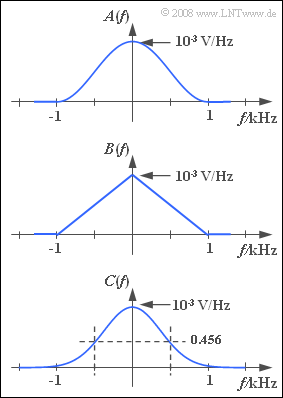Exercise 2.1Z: Distortion and Equalisation
From LNTwww
(Redirected from Aufgabe 2.1Z: Verzerrung und Entzerrung)
Three continuous spectral functions are depicted in the graph:
- a cos2–spectrum that has components only in the range $|f| < 1 \ \rm kHz$ where the following holds:
- $$A(f) = 10^{\rm -3} \ {\rm V}/{\rm Hz} \cdot \cos^2(\frac{|f|}{1 \, \rm kHz} \cdot \frac{\pi}{ 2} ) ,$$
- a triangular spectrum which is also limited to the frequency range $|f| < 1 \ \rm kHz$:
- $$B(f) = 10^{\rm -3} \ {\rm V}/{\rm Hz} \cdot \left(1-\frac{|f|}{1 \, \rm kHz} \right),$$
- a so-called Gaussian spectrum:
- $$C(f) = 10^{\rm -3} \ {\rm V}/{\rm Hz} \cdot {\rm e}^{-\pi \hspace{0.05cm}\cdot \hspace{0.05cm} (f/{1 \, \rm kHz})^2} .$$
Furthermore, we consider
- a linearly distorting system $S_{\rm V}$ with $X(f)$ at the input and $Y(f)$ at the output, and
- the equalization system $S_{\rm E}$ with the input spectrum $Y(f)$ and output spectrum $Z(f)$.
The frequency responses of the two systems $S_{\rm V}$ and $S_{\rm E}$ are:
- $$H_{\rm V}(f) = \frac{Y(f)}{X(f)} , \hspace{0.3cm}$$
- $$H_{\rm E}(f) = \frac{Z(f)}{Y(f)} .$$
Please note:
- The exercise belongs to the chapter Classification of the Distortions.
- A complete equalization means that $Z(f) = X(f)$ holds.
Questions
Solution
(1) Yes is correct:
- This constellation is possible because $X(f)$ is also always different from zero for all $Y(f) \ne 0$ .
- For all frequencies less than $0.5 \ \rm kHz$ , $H_{\rm V} = B(f)/A(f) < 1$ causes an attenuation.
- In contrast, the frequencies between $0.5 \ \rm kHz$ and $1 \ \rm kHz$ are amplified by the system.
(2) Yes is correct:
- For this constellation, a complete linear equalization is also possible with
- $$H_{\rm E}(f) = \frac{Z(f)}{Y(f)} = \frac{A(f)}{B(f)} = \frac{1}{H_{\rm V}(f)}$$
- since both spectra extend exactly up to $1 \ \rm kHz$ .
(3) Yes is correct:
- This constellation is possible, too. The filter $H_{\rm V}(f)$ must form a triangular spectrum for the frequencies $|f| <1 \ \rm kHz$ out of the Gaussian spectrum and suppress all frequencies $|f| > 1 \ \rm kHz$ .
(4) No is correct:
- A complete equalization is not possible here:
- The parts of the Gaussian spectrum, which are completely eliminated by $H_{\rm V}(f)$ , cannot be recovered by the linear system.
(5) No is correct:
- This constellation is not possible with a linear system since there cannot be any spectral components included in the spectrum $C(f) = A(f) \cdot H_{\rm V}(f)$ that do not exist in $A(f)$ .
- The question whether there is a non-linear system which forms a Gaussian spectrum out of the $\cos^2$-spectrum is not asked and therefore does not need to be answered: The authors rather believe "no".
